#möbius klein
Explore tagged Tumblr posts
Text
blood meridian / american psycho / i have no mouth and i must scream

disclaimer: these quotes are taken off-context and have been purposefully changed to fit better the context of my story. möbius is NOT like judge holden at all. and [redacted] isnt like patrick bateman either. hes still just as crazy though
#oc stuff#artists on tumblr#oc artwork#my art#[redacted]#möbius klein#art#writers on tumblr#blood meridian#american psycho#i have no mouth and i must scream#ihnmaims#quotes#M4-R10N
16 notes
·
View notes
Text


Finally some poetry of interest to me
522 notes
·
View notes
Text
youtube
Four Dimensional Maths: Things to See and Hear in the Fourth Dimension - with Matt Parker
#matt parker#break the 4th wall? try breaking the 4th dimension!#mathematics#stand-up comedy#the royal institution#möbius strip#torus#klein bottle#hypercube#''be not afraid!''
0 notes
Text
Holy shit! The prophecy has been fufilled! A bug walking around on a Möbius strip can cover the whole area without having to ever cross a line!!! Now we just need to have it get onto a Klein bottle.
3K notes
·
View notes
Text
Fun with Geometry: Shapes You Didn’t Know You Needed
Geometry is far more than the basic shapes we learn in high school; it’s a world brimming with bizarre and captivating figures that push the boundaries of our imagination.
1. The Hypercube (Tesseract)
The hypercube, or tesseract, is the 4-dimensional analog of the cube. While we live in a 3-dimensional world, the concept of a fourth dimension has fascinated mathematicians and artists alike. A hypercube consists of 16 vertices, 32 edges, and 24 square faces, each one being a 3D cube in a higher-dimensional space.
In the real world, hypercubes don’t physically exist, but they serve as key tools in higher-dimensional geometry and theoretical physics. Think of them as a "spatial metaphor" for the kinds of higher-dimensional spaces used in string theory or machine learning. Mathematicians use them to explore the complex relationships between different dimensions. The tesseract also shows up in pop culture, notably in the movie Interstellar, where it represents the connection between time and space.
2. The Pentagon (Not Just in Architecture)
The regular pentagon (five sides of equal length and five equal angles) has a fascinating relationship with the golden ratio. If you draw diagonals within a regular pentagon, they intersect in such a way that the ratio of the longer segment to the shorter segment is the golden ratio (ϕ ≈ 1.618). This means that pentagons are not just aesthetically pleasing in architecture, they have deep connections to mathematical beauty.
In nature, sunflowers and pine cones exhibit pentagonal symmetry. The arrangement of seeds in the flower follows a Fibonacci spiral, and the spirals are governed by golden angle, which closely ties to the pentagon’s unique proportions.
3. The Dodecahedron
A dodecahedron is a regular polyhedron made up of 12 pentagonal faces, 30 edges, and 20 vertices. It is one of Platonic solids, which means each face is identical, and the same number of faces meet at each vertex. This geometric shape is not just abstract; it appears in various 3D modeling applications and is used in architecture, like in the London 2012 Olympic torch design.
What’s particularly fascinating is its appearance in pop culture. The dodecahedron serves as a crucial symbol in the book and movie adaptation of The Hitchhiker's Guide to the Galaxy (the "Meaning of Life" puzzle) and is part of a well-loved mathematical riddle known as the "dodecahedron paradox."
4. The Möbius Strip
The Möbius strip is a non-orientable surface with only one side and one edge, and it is a staple of topological geometry. The twist in a Möbius strip turns the concept of inside and outside on its head. Take a strip of paper, give it a half twist, and then join the ends. The result is a surface where you can trace your finger along its edge endlessly, without ever lifting it or reaching a boundary.
Mathematically, the Möbius strip is a symbol of non-orientability and plays a crucial role in knot theory and the study of 3-manifolds. The Möbius strip also sneaks its way into art and architecture, often used as a visual symbol of infinity or paradox in both visual and sculptural art forms.
5. The Klein Bottle
Another topological marvel is the Klein bottle, a non-orientable surface with no boundary. Unlike the Möbius strip, which has only one side, the Klein bottle essentially has a single continuous surface where both sides are connected in a higher-dimensional space. If you attempted to build one in 3D, it would have to intersect itself. However, it can be imagined in 4-dimensional space.
The Klein bottle's properties make it a critical concept in topology, with applications in advanced physics and geometry, particularly when studying the shape of the universe and space-time curvature.
6. The Truncated Icosahedron (Football Shape)
Have you ever wondered about the shape of a soccer ball? It’s a truncated icosahedron. This polyhedron has 12 black pentagonal faces and 20 white hexagonal faces, a geometric structure that makes it easy to create spherical objects with flat faces. The truncated icosahedron is a close-packed shape and appears in carbon molecule structures such as buckyballs (or fullerenes) used in nanotechnology.
7. The Archimedean Solids
The Archimedean solids are a set of 13 convex polyhedra, where each face is a regular polygon and the same number of faces meet at each vertex. These shapes, such as the icosahedron (20 faces) and octahedron (8 faces), pop up in all kinds of real-world applications, like in architecture and crystallography. In fact, many molecular structures (like the shape of viruses) reflect these highly symmetrical solids.
Next time you look at a soccer ball, admire a piece of modern art, or even browse through a movie with some mind-bending geometry, remember: the world is built on shapes you never knew you needed, and math is at the heart of them all.
#mathematics#math#mathematician#mathblr#mathposting#calculus#geometry#algebra#numbertheory#mathart#STEM#science#academia#Academic Life#math academia#math academics#math is beautiful#math graphs#math chaos#math elegance#education#technology#statistics#data analytics#math quotes#math is fun#math student#STEM student#math education#math community
16 notes
·
View notes
Text
globe earth, flat earth, toroidal earth
why not lenticular or d20 or perhaps klein bottle or möbius planet or hmm can we have a möbius saturn at least
4 notes
·
View notes
Text
Topological Spaces 13: Conclusions and Remaining Questions
We have almost come to the end of this series but first I'd like to give a little overview of what we've done and what more there is to topology!
I've put a few book recommendations at the end too!
Here is the link to the previous post.
In generalising the notion of continuity, we found a notion in which topological spaces are "the same" (more formally, it is possible to show that homeomorphisms define an equivalence relation on class of topological spaces). We have also found certain properties of spaces which remain invariant under homeomorphisms:
(path-)connectedness
compactness
Hausdorffness
Second Countability
These invariants allow us to tell when spaces aren't homeomorphic. Having these invariants is extremely helpful since the task of classifying topological spaces up to homeomorphism is an insurmountable one, even when restricting to "nice" spaces. These are not the only homeormophism invariants, just the common ones.
There are a couple of questions that we haven't really answered in these posts:
How do we know the spaces in post 12 are not all homeomorphic?
When is ℝⁿ≅ℝᵐ?
Although the spaces in post 12 look different, how do we show that rigorously? How do we know that S¹ isn't homeomorphic to S²? One tool is orientability. Loosely, a space is orientable if no matter how you traverse the space, your orientation is preserved. It turns out orientability is a homeomorphism invariant. Spheres and tori are orientable whereas the Möbius band, Klein bottle, and real projective spaces are non-orientable. Another invariant is something called the Euler characteristic which is a number associated to (some) topological spaces which helps us further distiguish between these spaces.
Another approach is to associate algebraic structures to topological spaces in such a way that homeomorphisms induce isomorphisms between those algebraic structures. This is the realm of algebraic topology and provides us with machinary sophisticated enough to prove a lot of things which are otherwise extremely hard to prove.
The second question may seem obvious. It must be only when n=m right? That is indeed the case, but how do we prove that? In the case where n=1, we can easily show that by removing a point from ℝ and ℝᵐ for m>1. ℝ\{0} is not connected but ℝᵐ\{0} is so they are not homeomorphic, so we can conclude that ℝ and ℝᵐ can't be homeomorphic. Technically we must show that if f:X->Y is a homeomorphism and A⊆X, then A is homeomorphic to f(A). However, doing this in general is not so easy. Sure, we could go to ℝ² and remove a line and say that ℝᵐ with a line removed is still connected but ℝ² isn't and then go to ℝ³ and repeat with a higher dimensional subspace. But this strategy of going case by case is not productive and would literally take forever. So is there a quicker way? Using something called homology groups, we find that ℝᵐ\{0} and ℝⁿ\{0} have different homology groups and therefore cannot be homeomorphic. Of course that is skipping over a tonne of theory.
Book recommendations:
Introduction to Metric and Topological Spaces by Wilson A. Sutherland. The structure of this series is heavily influenced by this book. There is an emphasis on building intuition for definitions and is great first reading of topology (in my opinion)
Topology by James Munkres. This book is full of a lot more than what we've covered here. Whilst I haven't read it cover to cover, I've found the sections I have read have been clear.
There's not anything else that I'd like to talk about in this post. If anyone has any questions about topology, don't be afraid to ask! The whole reason I started this post series is a mutual sent in an ask about topology.
7 notes
·
View notes
Note
🌻 give me your wisdom
hmmmm. youve probably heard of the möbius strip, which is a 3d shape that only has one side, but it also has two edges which means its not at peak topology. that award goes to the klein bottle, which is a 3d shape that only has one side and NO edges - whichever way you travel in one direction on the klein bottle, you'll always end up going back to where you started in the end, without ever skipping over to the opposite end of your path! and best of all these shapes can both be made in real life yippee
4 notes
·
View notes
Note
Sorry to bother you again but have you done origami? If you haven't I'd love to see some origami from you!
Hi there! Yeah, it's alright. I like receiving asks/messages, tough it often takes a lot of time for me to reply. (Sorry for that.)
I already made some Origami, and I want to share once I feel able or motivated to photograph them.
(I find photographing Origami crafts veeery difficult.)
I made some modular Origami, and I also created a Shishabo cube with 12 irregular tetrahedron modules that a friend has shown me. (My friend created those modules, and we sometimes/often do Origami together.)
- - -- ---
My recent Origami craft was this stacked flower petal thingy
(It is an art object. But it can also be used as tiny sorting box for stuff like earrings, piercing jewelry or tiny crafting utensils.)
Top view:
(I added a hook made from wire. )
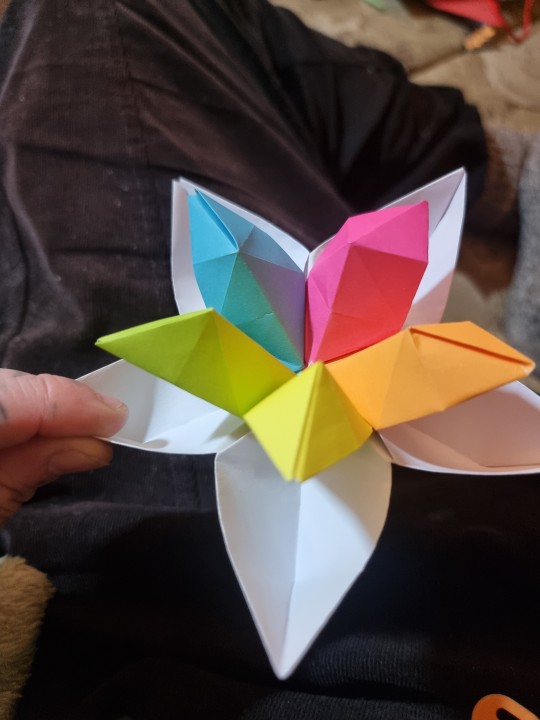
Bottom view:
(with a bead and wire at the center)
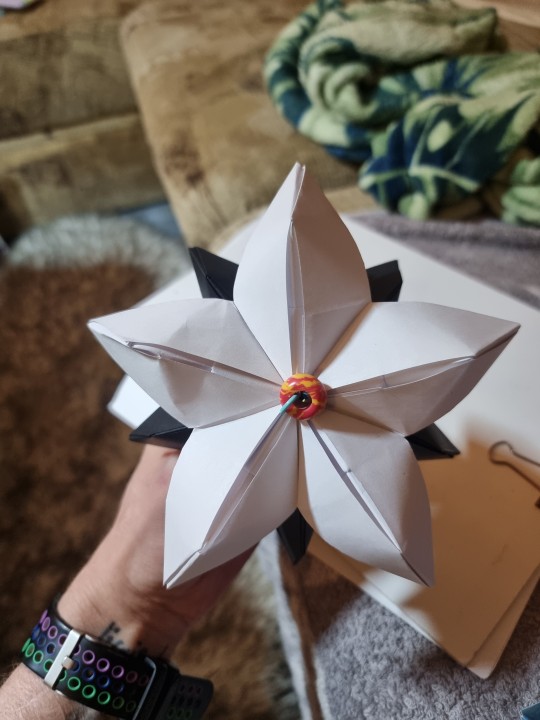
Three layers: (plus I attached two tiny red leather möbius strips, a blue origami link that my friend has given me and a tiny glass klein bottle below.)
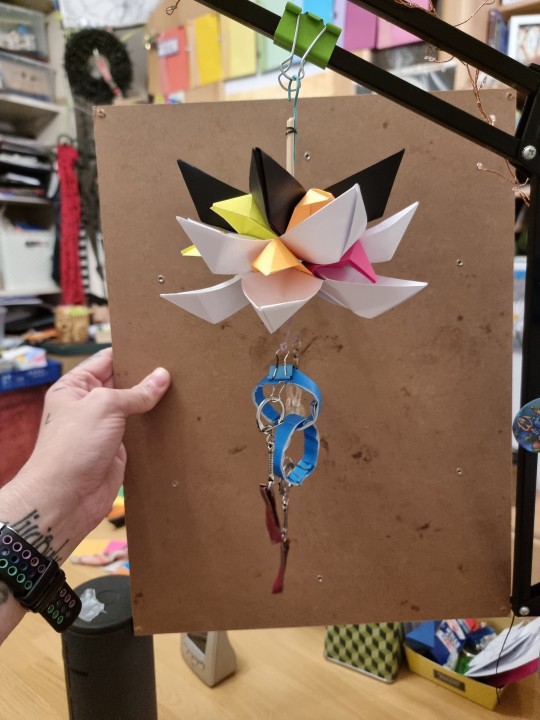
Attached to furtherly add a second layer:
(white and pretty neon colors)

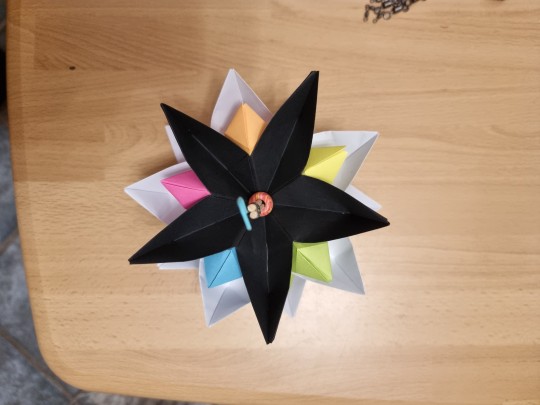
These are other "flower petal boxes" I made:
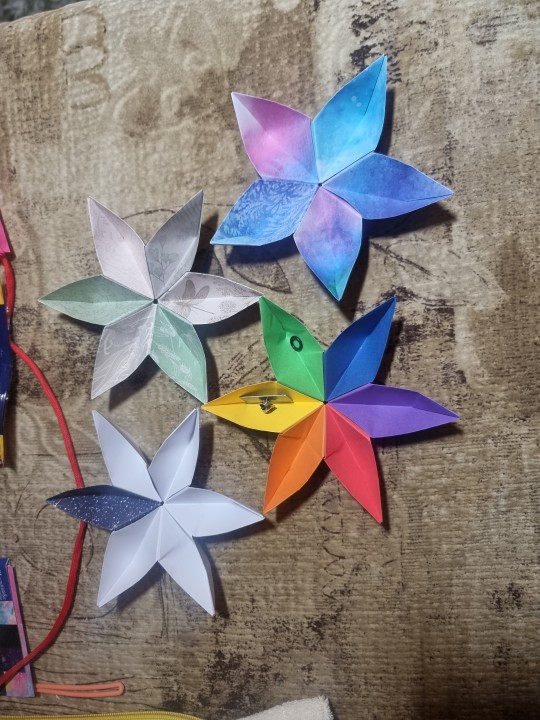
Making the modules is fun. I can also do it blindly. (Helpful if my eyes are very tired but I want a calmful activity to do.)
- - -- --- -----
I want to share some other origami soon. (I will tag it as "origami". )
#origami#asks#ask#boothehand#geometry#modular origami#origami crafts#flower petals#sorting box#artsy
13 notes
·
View notes
Note
Klein bottle:

If you've ever heard of a mobius strip, it's kind of like that but 3d. It has no volume.
I have in fact heard of a Möbius strip! but now why is it 3D. there is no need.

for real though how does it not have volume? it’s got insides so why no volume?
12 notes
·
View notes
Text


Is TIME a Möbius/Klein TORUS that BOTH 'Processes' (Forward Direction) and 'Precesses' (Backward Direction) through the Zodiac simultaneously?
Why did the ancient Egyptians and Sumerians use a 360 Day Calendar, where 1 Day = 1° of Rotation around the Sun? We don't know exactly but perhaps it is because the solar calendar is 365.24 days while the Lunar calendar is 354.8 days. The Mean Value of the Solar and Lunar Calendar is 360 Days....matching the both Egyptian and Sumerian Ancient Calendars.
'Procession' through the Zodiacal Equinox takes 360 days or 8,640 Hours (Horus) for one complete rotation. In this context its takes approximately 1 month to traverse from one zodiac into the next (for example Aquarius ♒️ into Pisces).
However, 'Precession' through the Zodiacal Equinox requires 24,000 years to complete its 'backwards' cycle. We are now in the Age of ♒️ Aquarius having just completed the Age or AEON of Pisces. Each AEON is approx 2,000 years in duration.
Time speeds up and slows down during the cycle, with the long end of the cycle being 12,960 years and the short end of the cycle being only 11,040 years. The total Cycle rotation is therefore 24,000 years. This is due to Mass-Time Dilation as a result of the increased Gravity on the short side of the cycle. 24,000 years = 8,640,000 Days...
*The Sun is approximately 864,000 miles in Diameter
*Jupiter is approximately 86,400 miles in Diameter
*There are 86,400 Seconds in One Day...
Gravitational Constant 'G' = 6.674 x 10^-11 m^3 kg^-1 s^-2
G / (√π - 1) = 8,640 (Hours in One 'Balance' Year)
{G / (√π - 1)}*10^3 = 8,640,000 (Days in One Great Year)
All of Time's 'Sexagesimal' (Base60) Calculations are derived using only the number 24 and its 'Orders of Magnitude' (2.4, 240, etc)...and 2+4 = 6.
1. The Great Year = 24,000 'Balance' Years
2. 'Balance' Days in One Year = {(2.4*2.4)+.24}*{(2.4*24)+2.4)} = 360
3. Hours in One Day = 24
4. Minutes in One Hour = (2.4*24)+2.4 = 60
5. Seconds in One Minute = (2.4*24)+2.4 = 60 (there are 86,400 seconds in One Day)
Robert Edward Grant
Illustrations by Robert Edward Grant
#robertedwardgrant #timeasakleintorus #simulationtheory
3 notes
·
View notes
Text
textpost goobers






#artists on tumblr#art#oc artwork#oc stuff#my art#doodles#rkgk#textposts#[redacted]#alexei molyboha (oc)#cornelia bellini (oc)#marion (oc)#möbius klein
7 notes
·
View notes
Text
The wizest wizard fashion their towers like Klein bottles; spaces that loop back on themselves through the dimension only wizards see and move through. Their scrolls, twisted into Möbius loops, hint at the greater nature of the structure, but only experiencing the enclosure enrichment offered to the pet shrimps can really provide the insight intrepid wanderers need to survive, thrive, or escape.
With shrinking powder and adhesive air and a second dose of shrinking powder, they ought journey to the fifty gallon ocean and tumble through the kalioscope, refracting across the mirrors until the vibrant sands renders them smooth enough to filter through the holes unknoticable from outside the ghotignit mirror prism. As they soak back into the ocean, they'll witness those unique hues of pink and xanh, which words falter before, dancing along the edges of
Glass

Narrative Function
The aspect of Glass filters the world through the prospectives, perception, and points of view of characters. It's a subtle aspect that's often invisible to the audience unless attention is explicitly drawn to it: This attention can manifest in any number of ways, but the most direct method is the exploration of how different qualia, different modes of perceiving reality cause characters to navigate the same material conditions differently: The reflection is different depending on which fun-house mirror you see things through.
Player Tendencies
Glass players are often envious in some capacity, looking through windows into the lives others have had, which for whatever reason they could not. They also tend towards introspection, though their self-reflexive view can be deeply warped by whichever fun-house mirror they use for self-reflection.
Because of their nature as understanders of qualia, Glass players a capacity toward adopting the qualiative intuition that players have for their aspects about additional aspects beyond Glass. This allows Glass players to fill gaps in the session roster or compare notes with fellow session members; However, adapting to the intuition of another aspect puts a massive strain on the Glass player, and repeatedly doing it or doing it with multiple aspects at once exponentially increase the risk that the Glass player will shatter into Glass shards.
Glass shards are splinters of a Glass player which have been locked into the qualia of another aspect. They act upon their shatter-locked aspect like a very weak player, and even if all shards are considered together, theyr much weaker than the whole and unshattered Glass player would be.
Powers
Literal: The manipulation of glass. Metaphorical: Qualiatic perception; the ability to see shrimp colors. Rational: Becoming invisible/transparent, manipulating the fragility of themselves and the world around them. Irrational: Changing character prospective
2 notes
·
View notes
Note
tricker treat!!!!
You get the Klein bottle! Similar to the Möbius strip, it is a one-sided, non-orientable surface— you could travel along it in a straight line and return to where you started, the only difference being that you’ve flipped upside down. Unlike the Möbius strip, a Klein bottle cannot be properly constructed in 3D space.
4 notes
·
View notes
Text
Moe (to english) -> cinnamon bun
Möbius (to closed geometry) -> to—shit. No. It’s a Klein bottle.
Strip -> stripper
Together:
Cinnamon Klein seductress
I am not a straight people.
Reblog if you are also not a straight people.
272K notes
·
View notes
Text
Existe-t-il une topologie chez Sigmund Freud et celle-ci est-elle à l’origine de la théorie topologie développée par Jacques Lacan ? (Alexandre Bleus)

Cher lecteur,
En guise de préalable, la question de l’existence d’une topologie chez Sigmund Freud et de son rôle éventuel comme origine de la topologie lacanienne est une interrogation plus que légitime. Il est tentant de chercher une continuité, une filiation directe entre le maître et le disciple, mais une analyse attentive révèle une distinction cruciale entre l’usage freudien de métaphores spatiales et l’introduction par Jacques Lacan d’une topologie formelle et mathématique.
Pour aborder cette question, il est essentiel de revenir à l’œuvre de Sigmund Freud. Vous le savez sans doute, Freud a fréquemment eu recours à des métaphores spatiales pour décrire l’appareil psychique. Des termes tels que “inconscient”, “préconscient”, “conscient”, ou encore les concepts de “première topique” (conscient, préconscient, inconscient) et de “seconde topique” (ça, moi, surmoi) témoignent de cette spatialisation de la psyché. Ces “topiques” freudiennes, comme on les nomme, sont en réalité des modèles descriptifs qui utilisent un langage spatial pour illustrer le fonctionnement psychique, les relations entre les différentes instances, et les dynamiques de refoulement et de conflit. Il est crucial de souligner ici que ces topiques freudiennes demeurent fondamentalement métaphoriques et descriptives. Elles ne constituent pas une topologie au sens mathématique du terme, mais plutôt un cadre conceptuel utilisant des analogies spatiales pour rendre compte de la complexité de l’esprit humain. Comme l’ont soulignés Laplanche et Pontalis dans leur Vocabulaire de la psychanalyse, le terme de “topique” chez Freud désigne avant tout une “théorie qui classe les processus psychiques selon un certain nombre de systèmes doués de caractères ou de propriétés différents” (Laplanche & Pontalis, 1967, p. 495). Il s’agit donc d’une organisation théorique, et non d’une formalisation mathématique.
Jacques Lacan, quant à lui, a introduit une rupture épistémologique majeure en intégrant la topologie mathématique au sein de la psychanalyse à partir des années 1950 et 1960. Lacan ne s’est pas contenté d’utiliser des métaphores spatiales ; il a emprunté des concepts formels et des figures géométriques issues de la topologie mathématique, telles que la bande de Möbius, le tore, la bouteille de Klein, et les nœud borroméen, pour modéliser la structure de l’inconscient, la subjectivité, et les relations entre le Réel, le Symbolique et l’Imaginaire. Et vous savez à quel point je considère le noeud borroméen comme le coeur de la théorie analytique lacanienne. Pour Lacan, la topologie n’est pas simplement une illustration, mais un outil conceptuel fondamental pour penser la structure même de l’inconscient. Il considérait que la structure du langage et de l’inconscient était intrinsèquement topologique. Comme l’explique Ragland-Sullivan dans Lacanian Psychoanalysis: Direction in Theory and Practice, Lacan a vu dans la topologie un moyen de dépasser les limites du langage descriptif et de saisir la structure même du sujet et de son inconscient (Ragland-Sullivan, 1986). La topologie lacanienne se veut une formalisation de la structure psychique, utilisant des outils mathématiques pour représenter des relations complexes et des configurations spatiales spécifiques.
La différence fondamentale réside donc dans la nature même de la “topologie” en question. Chez Freud, nous sommes face à une topique, c’est-à-dire une description des lieux psychiques à travers des métaphores spatiales, un modèle descriptif. Chez Lacan, il s’agit d’une topologie mathématique, utilisant des concepts formels et des figures géométriques pour représenter des structures psychiques d’une manière qui se veut plus rigoureuse et formelle. L’objectif diffère également : pour Lacan, la topologie est un outil pour penser la structure même de l’inconscient et du sujet, tandis que pour Freud, les métaphores spatiales sont davantage des outils heuristiques pour comprendre et communiquer ses concepts psychanalytiques.
Peut-on alors affirmer que la “topique” freudienne est à l’origine de la topologie lacanienne ? Il serait plus juste de dire que les métaphores spatiales freudiennes ont pu constituer un point de départ ou une inspiration pour Lacan. Freud, en spatialisant l’appareil psychique, a ouvert la voie à une réflexion sur la structure et l’organisation de l’inconscient. Cependant, Lacan a opéré un véritable tournant en important la topologie mathématique, transformant une simple métaphore en un outil conceptuel et formel. La topologie lacanienne n’est donc pas une simple continuation ou un développement direct de la topique freudienne, mais plutôt une rupture et une formalisation radicale. Comme le souligne Fink dans The Lacanian Subject: Between Language and Jouissance, Lacan utilise la topologie pour aller au-delà des limites du langage et des représentations linéaires, cherchant à saisir la structure complexe et paradoxale du sujet (Fink, 1995). La topologie lacanienne représente par conséquent une innovation théorique majeure, marquant une rupture épistémologique au sein de la psychanalyse, et il est essentiel de comprendre cette distinction pour appréhender la spécificité de la pensée lacanienne.
Dans mon prochain article, je vous parlerai des rapports qu’ entretiennent le Surmoi, le Moi et l’ Inconscient (soit la deuxième topique freudienne) avec le noeud borroméen.
(https://www.alexandre-bleus.org/existe-t-il-une-topologie-chez-sigmund-freud-et-celle-ci-est-elle-a-lorigine-de-la-theorie-topologie-developpee-par-jacques-lacan/)
Alexandre Bleus
0 notes